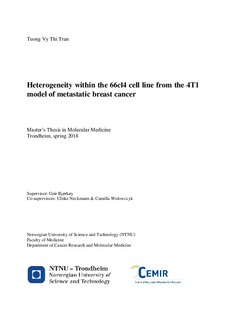| dc.description.abstract | Breast cancer is one of the most common form of cancer among women globally and metastasis is the primary cause of death in breast cancer patients. In the past decades it has been increasingly known that tumors are heterogenous masses of different cells that can be highly diverse. The study of tumor heterogeneity is important as it might how it might disturb therapeutic resistance as what might work for some cells in the tumor might have no effect on other cells. Tumor heterogeneity can be divided into two categories inter-tumoral heterogeneity and intra-tumoral heterogeneity. In addition, the cancer cells within the tumor may also acquire different phenotypes as the tumor grows and the cells are expanding from the first single fully transformed cell. Tumor cells are surrounded by the tumor microenvironment that comprise of many different cells and a variety of components that can promote tumor progression and metastasis. The 66cl4 cell line which is one of the cell line in the 4T1 breast cancer mouse model was used to obtain sub-clones and identify the heterogeneity of several genes that might play a key part metastasis of tumor cells.
We investigated the heterogeneity of cell line 66cl4 sub-clones and examine the sub-clone’s phenotype. Markers from BMP4 and NFE2L2 signaling pathway as well as the 66cl4 sub-clones ability to proliferate and colony formation were analyzed. Immunoblots and qPCR showed that the sub-clones did not differ in their level of the BMP4 and pSMAD but did indicated sign of heterogeneity with respect to GREM1 protein and mRNA level. No correlation between GREM1 and CD24 level were observed. In addition, all the sub-clones had the same CUL3 mutation and NFE2L2 protein and mRNA level. NFE2L2 regulated genes, HMOX1 and NQO1, varied between the sub-clones at both protein and mRNA level. The phenotype of the 66cl4 sub-clones did not demonstrate differences with respect to proliferation rate and ability to form colonies in soft agar. However, a reduced ability to form colonies was observed in all the sub-clones when compared to the 66cl4 mother cell line.
Further research is however needed to see if the 66cl4 sub-clones are heterogenous based on the chosen markers analyzed in this thesis. | nb_NO |
